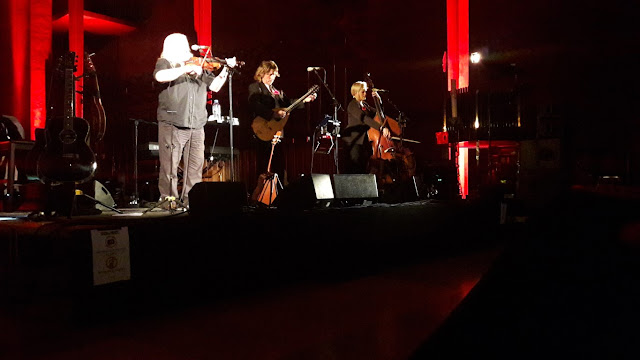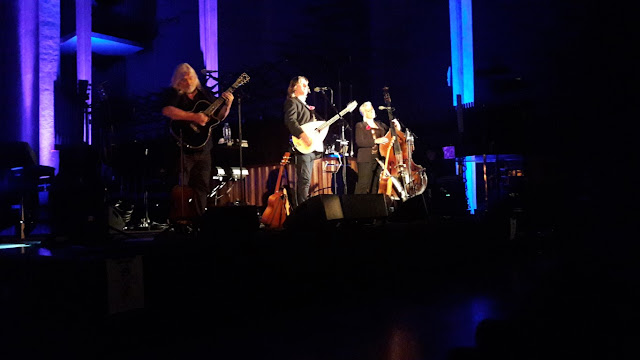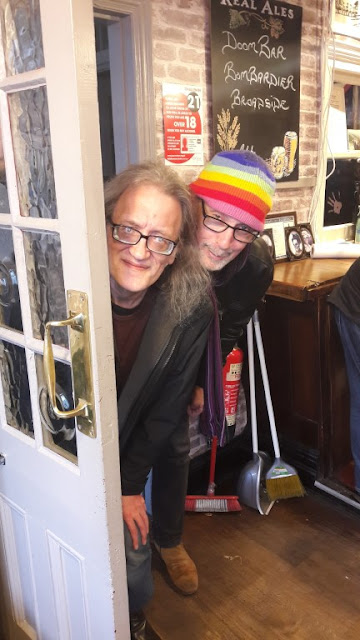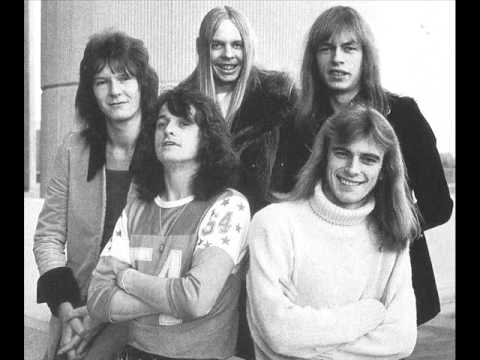Crokodile Tears
by Pete Clemons
I recently spent a delightful hour or two in the company of a couple of Coventry musicians who, it is fair to say, have both been at the bedrock of a large part of the local music scene for almost forty years.
We chatted and reminisced about how and where the pair first came to meet up, the bands they have been associated with, and the music they have created from the late 1970s and through to the present day.
But as you will read, and as tends to happen in these situations, a web began to weave around interactions with other bands and other associations they made along the way.
I am talking, of course, about Christopher Sidwell and Alf Hardy – collectively known nowadays as Crokodile Tears. Christopher was born in Meriden but has lived in Coventry for the vast majority of his life while Alf is one hundred per cent Coventry born and bred.
Crokodile Tears could be considered a satirical band. But both Christopher and Alf are very serious musicians although they do enjoy injecting humour into their music. As such, the songs they create are a mixture of serious and tongue in cheek. Alf is a multi-instrumentalist including guitar and keyboard while Christopher plays guitar and, after many years, is now proficient on the Stylophone.
Christopher, for almost all of his life, has been into writing songs and this interest was shaped by his own enjoyment of bands like Pink Floyd, particularly their early sound, and the Bonzo Dog Doo Dah Band who combined music with surreal humour. He formed his first band, The Digital Dinosaurs towards the end of the 1970s. Digital Dinosaurs entered a couple of battle of the bands at the ‘Lanch’ which, incidentally, were won by The X-Certs and The Swinging Cats. Although the Digital Dinosaurs were, not so much interested in winning, but more finishing last by creating the worse sound they could manage. John Bradbury, of the Specials fame, drummed on some Digital Dinosaurs album recordings as both Christopher and John had known each other at Binley Park School.
Meanwhile at around the same time one time King Henry VIII pupil, Alf Hardy, was with a band called Johnny Matthews and the Big Time Show Band. This was a performance art band that only played a couple of gigs at venues like Busters and General Wolfe. I did notice a wry smile appear on Alf’s face when he recalled this band.
Alf went onto a band called Evil Wind that tended to move within the club scene at venues like the Hope and Anchor and, later, the Colin Campbell. On one occasion the Digital Dinosaurs were supporting Evil Wind at the Hope and Anchor and toward the end of their set Christopher ended up getting custard pie’d by Alf. Evil Wind, it turned out, was way ahead of their time in terms of Vic Reeves style comedy. Now known as the custard pie incident, this is how Christopher and Alf met. In fact Christopher ended up joining Evil Wind for a short time.
During 1983 Christopher formed his first phase of Crocodile Tears. Initially this was a solo project but then it grew into a duo when Paul Sampson who as well as being a producer, already fronted his own band The Pink Umbrellas, teamed up. The band grew again as, basically, the rest of The Pink Umbrellas, namely Steve Edgson, Robin Hill and Barry Jones also worked with The Crocs. And it was with this extended line-up of Crocodile Tears that released their debut album during 1985. The album itself was recorded at Cabin Studios where Paul Sampson would become the house producer. And despite the Pink Umbrellas disbanding, this format of the Crocodile Tears line up would continue through to around 1986 when phase 3 of the band would begin.
Going back slightly in time to the very early 1980s there was a band around called Hot Snacks (or Snax). When they disbanded, towards the mid-80s, there emerged a song writer called ‘Ollie’ also known as Doc Mustard. You may recall seeing him busking in town with his dog Paxo. Ollie’s song writing led to a musical partnership with Jerry Richards who became known as Doc Mustard and the Colbalt Kid. Ollie (or ‘Doc Mustard’) released the single ‘Nuclear Boogie’. And it was through Doc Mustard and the Colbalt Kid that Alf Hardy first came across Jerry Richards who had arrived in Coventry via Wales at a very young age. Around 1998 Doc Mustard actually helped record and performed on an unreleased second Crocodile Tears album imaginatively called, ‘Crocodile Tears 2’.
The crossing of paths for Jerry and Alf would ultimately lead to the creation of Tubilah Dog who existed between 1985 and 1990. Apart from local gigs Tubilah Dog, who also included during their existence Steve Mills – Vocals, Tim Kelsall – Bass, Andy Copeland – Drums, Mark Bannister – Rhythm Guitar, John Oddy – Bass and Ashley Dreher – Bass, Steve Hands – Drums, quickly established themselves on the free festival circuit alongside bands like Spaceman 3, Suicide and Hawkwind. Tubilah Dog also produced their sole LP the ‘In Search of Plaice’ album. And for those who are familiar with Hawkwind will notice a play on words at work here.
The free festival scene, attended by Tubilah Dog, gave rise to many new alliances. Some of which would continue for years to come. Alf Hardy, for example, linked up with Peter Kember, also referred to as Sonic Boom and best known for being a founding member of the experimental rock band Spacemen 3. After the demise of Spaceman 3 Alf became a part of future Peter Kember projects like Spectrum and Experimental Audio Research (or EAR).
The early 1990s also saw Alf being invited to work as an engineer at Cabin Studios by its original creator Jon Lord, who would eventually take over its day to day running, after Paul Sampson decided to relocate to London. With all these overlapping musical projects it was a busy time for Alf who was also sound engineer at the Stoker on Binley Road. Alf would remain at Cabin till the studios demise during 2008.
During his time at Cabin there were many highlights and Alf remembers names like U.S. band Silver Apples and Black Sabbath lead guitarist Tony Iommi recording there. The lesser known 60’s band The Purple Gang also recorded there with Paul Sampson. As did Bad Manners, which by all accounts, was a great laugh. He even remembers (as does Chris) tripping over Cerys Matthews while she slept in her sleeping bag one morning just as Alf was arriving for work. Her band Catatonia had chosen to record at the venue and had lived in house during the sessions.
Another memorable session at Cabin occurred during 2003 when a band Jerry Richards was associated with, DanMingo chose to record there. Together with Jerry were Steve Swindells, Jon Moss and Winston Blissett each being members of Hawklords, Culture Club and Massive Attack respectively. ‘Shabba Ranks (‘Shabba’) was also present along with an un-named girl singer.
Jerry Richards had met Hawkwind’s Dave Brock at the previously mentioned festivals during 1987 and this meeting led to a collaboration of the two bands known as HawkDog. That initial meeting would prove to be significant and lead to Tubilah Dog supporting Hawkwind on several tours. Later on Jerry was invited by Dave Brock to join Hawkwind as lead guitarist in 1995. This, again, would lead to extensive touring through to 2002. And so the associations continued as Jerry would play bass in Nik Turners band, Space Ritual, following the departure of Dave Anderson. In parallel to a lot of the Hawkwind based activities Jerry also run other ongoing projects such as Earthlab and Paradogs that can be dated back as far as 1992.
And continuing the Hawkwind theme, during 2008, Jerry Richards was instrumental in resurrecting a band closely associated to Hawkwind called Hawklords. Hawklords, a loose collective, were originally active during 1978/79, released an album called ‘25 years On’, and was the last time poet and lyricist Bob Calvert was involved with the band. Joining Jerry in this reformation were Steve Swindells, Harvey Bainbridge, Ron Tree and Dave Pearse. And to this day Hawklords continue to tour and release new music.
But back to Crokodile Tears, and phase 3 of its history. And, for those following this tale then you will have already noticed the, by now, incorrect spelling of the word Crocodile. Christopher, by now, had reinvented the band and his musical partner from the Evil Wind days, Alf Hardy, teamed up with him once more in 1992. To differentiate the phase 1 identity of the band from the phase 2 version, Christopher removed the second ‘C’ and introduced the letter ‘K’ in the word Crocodile. In fact, for the purposes of related artwork the ‘K’ was actually the ‘K’ used on the Special ‘K’ breakfast cereal. Not only that, but for phase 3, ex Digital Dinosaurs guitarist Gordon Francis (The Amazing Gordoni’) and singer Elspeth Whisten (Elli Bongo) began to hook up with the band, further enhancing the bands the bands versatility. Eventually, that difficult second album, titled ‘Dodoism’ emerged for the Croks during 1997. Afterwards, a privately released third album,’Peacrok’, was issued to be followed by an album called ‘Go for the Jugular’ in 2005. This album phase 4 for the band saw them finally hooking up with Jerry Richards when commitments allowed him to.
Since then, things have picked up a pace in terms of recorded releases as The Croks released an album in 2007 called ‘Gullibles travels’, three years later ‘Words of Wisdom?’ (featuring phase 5 singer Amy McGuigan) followed by ‘If Hippies Ruled the World’ and finally, and most recently, ‘Made in Meriden’.
Mingled within those albums are several Croks songs that even relate to Coventry. These include ‘Under the elephant’, ‘The Merry-Go-Round’, ‘Gullibles Travels’, ‘Cathedral Lanes’ and ‘Much too good for Foleshill’ along with many more. Another song titled ‘My Favourite Weathergirl’ was written about Central TV weather girl Charlie Neil. And what’s more, Charlie was well aware of it – check out her Wiki page. Charlie dropped it into many a conversation.
Alf amusingly describes the style of Croks music as ‘Coventry and Western’. And all in all, The Croks have recorded and released an impressive total of eight albums. Nearly all are still out there in physical format or available to download. And to this day Christopher Sidwell and Alf Hardy continue to play live acoustically as a duo or as a trio with long-time contributor guitarist Jerry Richards.
Christopher always writing and currently and are currently recording as you read this. New songs to be unleashed on an unsuspecting world include ‘Erwin’ and ‘Bobby’. ‘Erwin’ is a song described by Christopher as one ‘I wrote with Alf that shows our softer, more thoughtful side’. He continued ‘I write very differently with Alf’. ‘Bobby’ is a typically daft song that I tend to write on my own, it is a protest song of sorts about ‘comb overs’.
Funnily enough both of these new songs are about fame – something the Croks have yet to experience! Christopher is now retired and spends his time as an artist and as a grandfather. Alf is also retired and in his spare time he creates jingles. But both are still devoted to the Croks, maybe more so now that more time allows. Male crocodiles are, apparently, especially vociferous in their bellowing so who knows what the future holds for this pair of free spirits. A couple of new albums planned for the future ‘Old Skool’ and ‘The End of an Error’ are already in the advanced planning stages……….
………………………………….
Massive thanks to both Christopher and Alf for both their time and contributions in completing this article.










